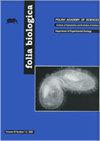Non-native Ponto-Caspian Gobies in the mouths of the Vistula River tributaries
IF 0.8
4区 生物学
Q4 BIOLOGY
引用次数: 0
Abstract
At present, four non-native gobiid species (racer goby Babka gymnotrachelus, monkey goby Neogobius fluviatilis, round goby Neogobius melanostomus and western tubenose goby Proterorhinus semilunaris) are listed as occurring in the Vistula River of Poland. In this work, the distribution and densities of gobiids in the river-mouth stretches of the Vistula tributaries flowing downstream from the Włocławek Reservoir in the Baltic Sea direction are presented. The fish were collected by electrofishing from a boat or while wading. Non-native gobiids were noted in 15 of the 18 tributaries studied. Among the 1,075 gobies caught, the western tubenose goby was the most common and occurred in 15 of the sites examined. The racer goby was registered in seven of the tributaries, while the monkey goby was recorded in only three. No round goby was caught. The highest densities of the western tubenose goby and racer goby were noted in the small stream located directly downstream from the Włocławek Reservoir. Among the species identified, the western tubenose goby seems to be more eurytopic because it was the last of these species to invade the Vistula River, but it is now the most widespread. In addition to a morphological identification of the fish, samples of each species were confirmed by an analysis of subunit I of the cytochrome oxidase (COI) barcode sequences. The genetic analysis of the COI subunit revealed that this sequence is effective for the taxonomic differentiation of the Ponto-Caspian gobies occurring in Poland. The results showed that gobiids have become a permanent element of the ichthyofauna of the Vistula and its tributaries that are available for migration Key words: invasive species, Gobiidae, Neogobius fluviatilis, Babka gymnotrachelus, Proterorhinus维斯瓦河支流河口的非本地的蓬托-里海虾虎鱼
目前,波兰维斯瓦河有4种非本地虾虎鱼(竞速虾虎鱼Babka gymnotrachelus、猴虾虎鱼Neogobius fluviatilis、圆虾虎鱼New gobius melanostomus和西管鼻虾虎鱼Proterohinus semilunaris)。在这项工作中,介绍了从Włocł; awek水库向波罗的海方向下游流动的维斯瓦支流河口河段的虾虎鱼分布和密度。这些鱼是在船上或涉水时通过电捕鱼收集的。在所研究的18条支流中,有15条出现了非本地虾虎鱼。在1075只被捕获的虾虎鱼中,西部管鼻虾虎鱼最为常见,在检查的15个地点都有发生。参赛虾虎鱼在七条支流中被记录在案,而猴子虾虎鱼只在三条支流中记录在案。没有捕到圆虾虎鱼。西部管鼻虾虎鱼和竞赛虾虎鱼的密度最高的是位于Włocł; awek水库正下游的小溪。在已确定的物种中,西部管鼻虾虎鱼似乎更具肉食性,因为它是最后一个入侵维斯瓦河的物种,但现在它是最广泛的。除了对鱼类进行形态学鉴定外,还通过分析细胞色素氧化酶(COI)条形码序列的亚基I来确认每个物种的样本。对COI亚基的遗传分析表明,该序列对发生在波兰的蓬托-里海虾虎鱼的分类分化是有效的。结果表明,虾虎鱼已成为维斯瓦河及其支流鱼类区系中可供迁徙的永久性组成部分。关键词:入侵物种、虾虎科、新虾虎鱼、Babka gymnotrachelus、Proterohinus
本文章由计算机程序翻译,如有差异,请以英文原文为准。
求助全文
约1分钟内获得全文
求助全文
来源期刊

Folia Biologica-Krakow
医学-生物学
CiteScore
1.10
自引率
14.30%
发文量
15
审稿时长
>12 weeks
期刊介绍:
Folia Biologica (Kraków) is an international online open access journal accepting original scientific articles on various aspects of zoology: phylogeny, genetics, chromosomal studies, ecology, biogeography, experimental zoology and ultrastructural studies. The language of publication is English, articles are assembled in four issues per year.
 求助内容:
求助内容: 应助结果提醒方式:
应助结果提醒方式:


